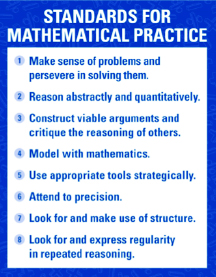
By Kitty Rutherford, Posted April 13, 2015 –
The Common Core’s Standards for
Mathematical Practice (SMPs) focus on what it means for students to
be mathematically proficient. I have heard many people say that the SMPs are
the heart and soul of the Common Core State Standards for Mathematics (CCSSM). These
standards describe student behaviors, ensure an understanding of math, and
focus on developing reasoning and building mathematical communication. Each
standard has a unique focus, but each also interweaves with the others as we
put them into practice. These practices empower students to use math and to
think mathematically. Our job as teachers is to help students develop these
practices to become effective mathematicians.
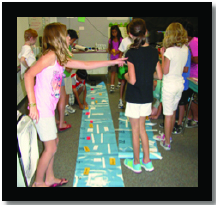
The SMPs describe varieties of
expertise that mathematics educators at all levels should seek to develop in
their students. These practices rest on important “processes and proficiencies”
with longstanding importance in mathematics education. The first of these are
the NCTM Process Standards of Problem Solving, Reasoning and Proof, Communication,
Representation, and Connections. Second are the strands of mathematical
proficiency specified in the National Research Council’s report Adding It Up:
adaptive reasoning, strategic competence, conceptual understanding
(comprehension of mathematical concepts, operations and relations), procedural
fluency (skill in carrying out procedures flexibly, accurately, efficiently and
appropriately), and productive disposition (habitual inclination to see
mathematics as sensible, useful, and worthwhile, coupled with a belief in
diligence and one’s own efficacy).
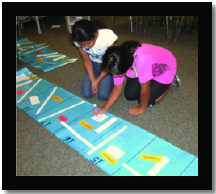
The SMPs are a
significant focus of CCSSM. These eight practices describe the thinking
processes, habits of mind, and dispositions that students need to develop a
deep, flexible, and enduring understanding of mathematics.
One way to build a deep understanding
of the SMPs is to read one practice at a time and reflect on the following
questions:
1. Why is this practice important?
2. What does this practice look like when students are doing it?
3. How can a teacher model this practice?
4. What could a teacher do within a lesson to encourage students in this
practice?
5. How can you assess proficiency in this practice?
Before CCSSM was
implemented, I visited a few fourth-grade mathematics classrooms. I presented a
cognitively
demanding mathematical task, and students worked
collaboratively together to solve it. I then introduced the SMPs by explaining
to students that these are standards that mathematicians practice to help them excel
in mathematical thinking. I asked students to think about the task they had just
solved: If they were to explain to someone what that practice meant or looked
like, how would they do it? After some discussion, students created posters to
represent their thinking about the SMPs. In this task, students explored prime or composite by
building possible rectangular arrays for the numbers 1–25. After the task and
much discussion, students created posters.
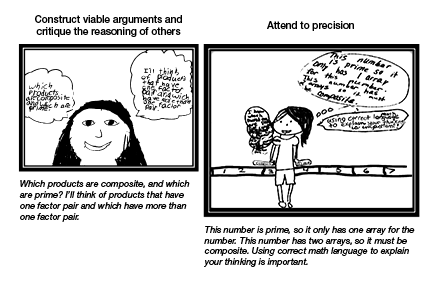
In another
fourth-grade classroom, students were given the task of finding the perimeter
of a figure. These are some of the posters of the SMPs that these students
created.

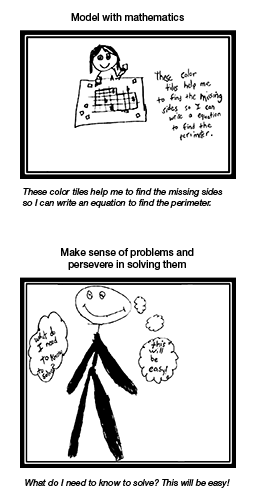
I noticed a blond, blue-eyed little boy sitting alone as he worked diligently on a simplistic drawing. As I approached, he looked up, and in a sincere, heartfelt tone he informed me that this was a picture of his friend persevering not only in math but in his everyday life. Pointing to the empty desk next to his, he whispered, “My friend has cancer. He is not in school today because he just received a cancer treatment a few days ago.”His comments shook me to the
very core. We do many of these practices every day, not just in mathematics!
Now it is your turn. Have a
conversation with your students about one of the Standards for Mathematical
Practice. Have them illustrate what they think it means.
 Kitty Rutherford serves as the
North Carolina Elementary Mathematics Consultant for the Department of Public
Instruction in Raleigh. She is an experienced leader, collaborator, and
licensed educator with a master’s degree in elementary education coupled with more
than twenty-seven years’ experience in teaching elementary school students,
training educators, collaborating with multiple stake-holders, and implementing
effective programs. She has received such honors as the Presidential Award for
Excellence in Mathematics and Science Teaching, NCCTM Outstanding Elementary
Mathematic Teacher, Alpha Delta Kappa State Excellence in Education Award, and
Teacher of the Year Finalist. She currently serves as the State Coordinator for
NC Presidential Award for Excellence in Mathematics Teaching and on the board
of North Carolina Council of Teachers of Mathematics.
Kitty Rutherford serves as the
North Carolina Elementary Mathematics Consultant for the Department of Public
Instruction in Raleigh. She is an experienced leader, collaborator, and
licensed educator with a master’s degree in elementary education coupled with more
than twenty-seven years’ experience in teaching elementary school students,
training educators, collaborating with multiple stake-holders, and implementing
effective programs. She has received such honors as the Presidential Award for
Excellence in Mathematics and Science Teaching, NCCTM Outstanding Elementary
Mathematic Teacher, Alpha Delta Kappa State Excellence in Education Award, and
Teacher of the Year Finalist. She currently serves as the State Coordinator for
NC Presidential Award for Excellence in Mathematics Teaching and on the board
of North Carolina Council of Teachers of Mathematics.